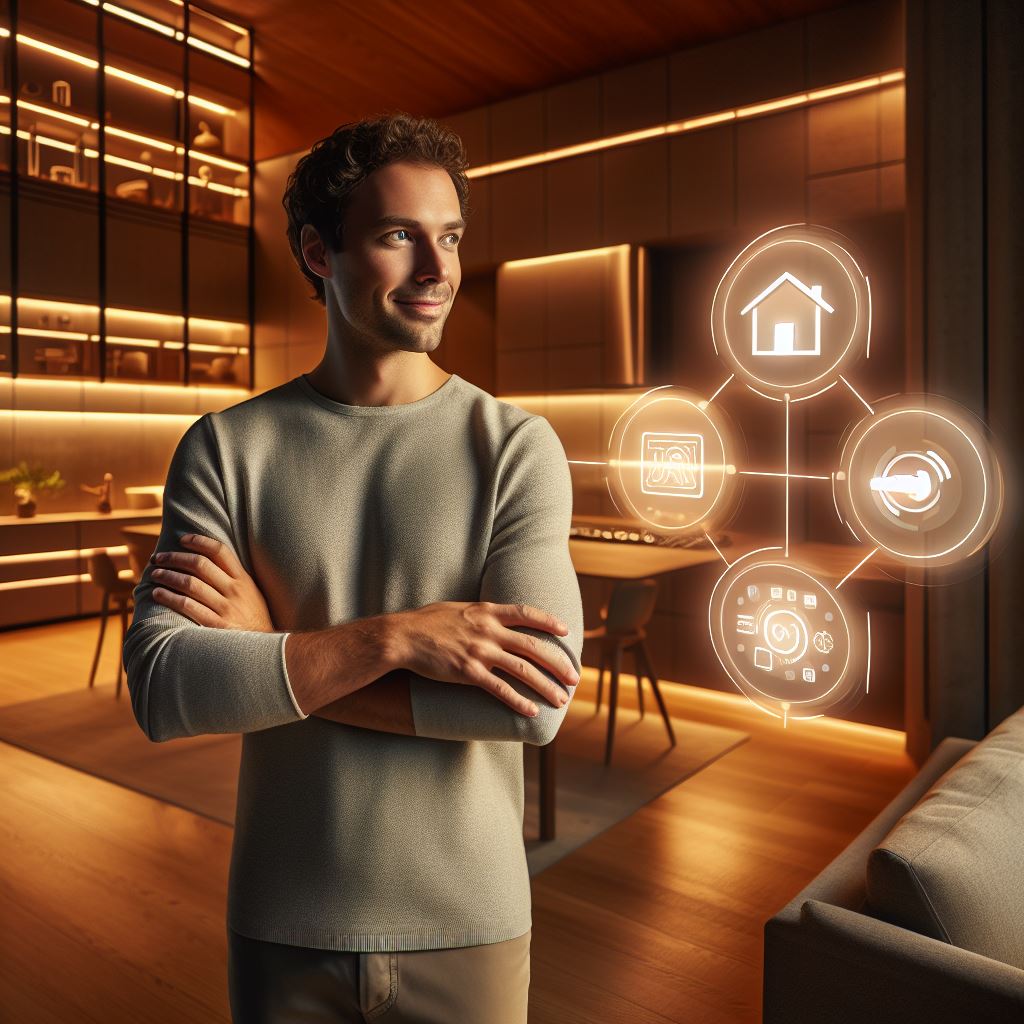Introduction
Smart homes refer to residences equipped with advanced automation systems that allow residents to control various aspects of their homes through Internet-connected devices.
In recent years, smart homes have experienced significant growth in popularity, thanks to the advancements in technology and increased awareness about their benefits.
Smart homes offer numerous advantages for residential living, making them an appealing option for many homeowners.
The growth and popularity of smart homes have soared in recent years, thanks to technological advancements.
Homeowners are increasingly recognizing the convenience and efficiency that smart homes offer.
From controlling lights and appliances remotely to managing security systems, smart homes provide a seamless living experience.
The benefits of smart homes for residential living are immense and extend beyond mere comfort.
With the ability to control various aspects remotely, homeowners can save on energy costs by adjusting thermostats and lighting based on their preferences and schedule.
Additionally, smart homes enhance security through features like automated locks and surveillance systems, providing peace of mind to residents.
Moreover, smart homes offer increased accessibility for individuals with disabilities or limited mobility.
With voice-activated controls and automated systems, tasks such as turning on/off lights or adjusting room temperature become easier, promoting independence and improving the quality of life for residents.
In essence, smart homes have revolutionized residential living by offering convenience, energy efficiency, enhanced security, and improved accessibility.
The increasing popularity of smart homes is a testament to their numerous advantages and the growing need for technologically advanced living spaces.
With continuous developments in automation systems, the future of residential living holds great promise for those seeking a seamless, connected environment.
The Advantages of Smart Homes
Increased convenience and comfort
Smart homes provide a high level of convenience by allowing homeowners to control various devices and appliances through a centralized system.
This means you can adjust the thermostat, turn on/off lights, or even start your coffee machine without getting out of bed.
By automating routine tasks, smart homes make daily life more comfortable and give you more time for leisure activities.
Energy efficiency and cost savings
One of the major advantages of smart homes is their ability to save energy and reduce utility bills.
Smart thermostats can automatically adjust the temperature based on your preferences and occupancy patterns, resulting in significant energy savings.
In addition, smart lighting systems can turn off lights when no one is in the room, further reducing energy consumption and saving you money in the long run.
Improved home security and safety
Smart homes offer enhanced security features that help protect your property and loved ones.
Smart security systems can include features such as surveillance cameras, motion sensors, and smart locks.
These systems allow you to monitor your home remotely, receive real-time alerts, and even lock or unlock doors from your smartphone.
By providing an extra layer of security, smart homes give homeowners peace of mind and a greater sense of safety.
Enhanced accessibility for people with disabilities or the elderly
Smart homes have the potential to greatly improve accessibility for individuals with disabilities or the elderly.
With voice-controlled devices and automation features, tasks that used to be challenging or impossible are now easily accomplished.
For example, smart homes can provide voice-activated controls for lighting, temperature, and even opening doors, making it more accessible for those with mobility issues.
This increased accessibility can significantly enhance independence and quality of life for individuals who would otherwise rely on assistance.
In fact, smart homes offer a range of advantages that make them the future of residential living.
They provide increased convenience and comfort by automating tasks and allowing remote control of devices and appliances.
Smart homes also bring significant energy savings and cost reductions through efficient use of resources.
Furthermore, they offer enhanced security features, ensuring the safety of your home and loved ones.
Lastly, smart homes increase accessibility and independence for individuals with disabilities or the elderly.
Overall, the benefits of smart homes make them an attractive choice for homeowners looking to improve their quality of life and create a more efficient and secure living environment.
Read: Urban vs. Suburban Development Shifts
The Role of Technology in Smart Homes
Technology plays a crucial role in the development and implementation of smart homes.
Through the use of various technologies such as the Internet of Things (IoT), artificial intelligence, and sensors, homes are becoming more connected and intelligent than ever before.
These technologies are integrated into various aspects of residential living, including lighting, heating, entertainment, and more.
Overview of the technologies powering smart homes (Internet of Things, artificial intelligence, sensors, etc.)
Internet of Things (IoT)
The Internet of Things (IoT) is a network of interconnected devices that communicate and share data with each other.
In smart homes, IoT allows devices like thermostats, door locks, and security cameras to be controlled remotely through smartphones or voice assistants.
For example, homeowners can adjust the temperature of their homes while they are away or receive real-time notifications if there is a security breach.
Artificial intelligence (AI)
Artificial intelligence (AI) is another technology that powers smart homes.
AI systems use machine learning algorithms to analyze data and make intelligent decisions.
In the context of residential living, AI can be found in voice assistants like Amazon Alexa or Google Home.
These devices can perform tasks such as turning on/off lights, playing music, or answering questions based on voice commands.
They can also learn from user behavior and adapt their responses accordingly.
Sensors
Sensors play a vital role in making homes smarter and more energy efficient.
These tiny devices can detect motion, temperature, light, and humidity, among other things.
How these technologies are integrated into various aspects of residential living (lighting, heating, entertainment, etc.)
By integrating sensors into various aspects of the home, residents can enjoy added convenience and energy savings.
For example, smart lighting systems use motion sensors to turn lights on/off automatically, reducing energy waste.
Smart thermostats use temperature sensors to adjust heating and cooling settings based on occupancy and weather conditions, further optimizing energy usage.
Smart technology is also making its way into entertainment systems within smart homes.
For instance, home theaters can now be equipped with voice-controlled projectors or smart TVs that offer seamless integration with streaming services.
Users can control their entertainment systems through voice commands or smartphone apps, creating a more immersive and user-friendly experience.
In addition to these specific examples, technology is continuously evolving and finding new ways to enhance residential living.
Smart homes are becoming more affordable and accessible, allowing a broader range of homeowners to benefit from these advancements.
As technology continues to advance, we can expect to see even more integration of smart devices and systems in our homes.
In short, the role of technology in smart homes is significant and ever-expanding.
The Internet of Things, artificial intelligence, and sensors are just a few of the technologies driving the development of smart homes.
From controlling lighting and temperature to enhancing entertainment systems, technology has the power to transform residential living.
As we continue to embrace and adapt to these advancements, the future of smart homes looks brighter and more intelligent than ever before.
Read: Garage Conversion Permits: Key Steps
Popular Smart Home Devices and Applications
Smart homes have revolutionized the way we live, providing convenience, comfort, and security like never before.
With the rapid advancement of technology, smart home devices and applications have become increasingly popular.
Here are some of the most sought-after devices and applications transforming residential living:
Smart Thermostats and HVAC Systems
Smart thermostats, such as Nest and Ecobee, allow homeowners to remotely control their home’s temperature and save on energy costs.
These devices can be easily programmed to adjust the temperature based on occupancy, weather, and preferences.
HVAC systems have also become smarter, providing efficient heating, ventilation, and air conditioning solutions.
Smart Lighting and Automated Window Shade
With smart lighting systems, you can control the brightness, color, and ambiance of your home’s lighting using your smartphone or voice commands.
Automated window shades offer convenience and energy efficiency by adjusting the amount of natural light entering your home based on the time of day or your preferences.
Voice Assistant Devices (Amazon Echo, Google Home)
Voice assistant devices, like Amazon Echo and Google Home, have become an integral part of smart homes.
These devices use artificial intelligence to perform various tasks based on voice commands.
From playing music to providing weather updates, voice assistants can simplify everyday tasks and make your home smarter.
Home Security Systems and Smart Locks
Smart homes prioritize security, and home security systems have become increasingly sophisticated.
Smart security cameras, motion sensors, and door/window sensors provide real-time surveillance and alerts.
Alongside, smart locks offer convenience and enhanced security by allowing remote control and access management of your home’s doors.
Smart Appliances (Refrigerators, Ovens, Washing Machines, etc.)
Smart appliances are changing the way we interact with everyday household tasks.
Refrigerators with built-in cameras allow you to see what’s inside without opening the door.
Smart ovens can be controlled remotely and even suggest cooking instructions based on the ingredients.
Washing machines can be programmed to start and finish cycles at specific times, optimizing energy usage.
These devices and applications have major implications for residential living, making homes more efficient, secure, and comfortable.
Additional benefits of embracing smart home technology
However, there are additional benefits that come with embracing smart home technology. Let’s explore some of these advantages:
- Energy Efficiency: Smart thermostats, lighting systems, and appliances contribute to energy conservation by optimizing usage and reducing wastage.
This not only helps the environment but also saves homeowners a significant amount of money on utility bills. - Convenience and Automation: Controlling various aspects of your home through a smartphone or voice commands offers unparalleled convenience.
From adjusting the temperature to turning off lights or even starting your coffee maker, automation simplifies everyday tasks and gives you more control over your living space. - Enhanced Security: With smart security systems and locks, homeowners can remotely monitor their property and receive real-time alerts in case of any security breaches.
This provides peace of mind and ensures that your home and loved ones are safe even when you’re away. - Personalization and Customization: Smart homes allow for personalization based on individual preferences.
From creating personalized lighting scenes to adjusting the thermostat settings for different times of the day, smart home devices can adapt to your lifestyle and make your home truly yours. - Aging in Place: Smart home technology can significantly improve the quality of life for seniors or people with disabilities.
From voice assistants that provide assistance and reminders to sensors that can detect falls, smart homes enable independent living and safety for all residents.
As technology continues to evolve, the possibilities for smart homes are limitless.
From advanced AI systems to interconnected devices, the future of residential living promises even greater convenience, efficiency, and comfort.
Embracing smart home devices and applications opens up a world of possibilities for homeowners, making their lives easier and more enjoyable.
Read: Rising Costs: Navigating Real Estate

Concerns and Challenges of Smart Homes
As the idea of smart homes gains popularity, there are a number of concerns and challenges that need to be addressed.
While the benefits of smart technology are undeniable, it is important to acknowledge and overcome these obstacles to ensure a seamless integration into our daily lives.
Potential security and privacy issues
With the increasing interconnectedness of smart devices, the risk of security breaches and privacy invasion becomes a major concern.
Hackers can compromise the network and gain access to sensitive information, leaving homeowners vulnerable.
The need for robust security measures is paramount to safeguard personal data.
Compatibility issues and integration challenges
One of the major challenges faced by smart homes is the compatibility between different devices and systems.
In a market flooded with numerous brands and technologies, ensuring seamless integration and communication between devices can be difficult.
Homeowners may face compatibility issues when trying to connect devices from different manufacturers.
Cost and affordability considerations
While the idea of a fully automated home sounds appealing, the cost of implementing smart devices can be significant.
The initial investment required for smart devices, installation, and maintenance can be a deterrent for many homeowners.
Achieving affordable smart homes remains a challenge for both manufacturers and consumers.
Lack of standardization and fragmentation in the market
The absence of a universally accepted standard for smart home technology hinders its widespread adoption.
This lack of standardization leads to fragmentation in the market, making it difficult for homeowners to find compatible devices and systems.
The presence of various competing platforms often results in a fragmented user experience.
Overcoming these concerns and challenges
To address and overcome these concerns and challenges, certain measures can be taken:
- Strengthening security protocols: Manufacturers need to prioritize security features and invest in ensuring that their smart devices and systems are built with strong security measures.
This includes encryption, regular software updates, and authentication protocols to protect against potential security breaches. - Increased collaboration and compatibility standards: Manufacturers should work towards developing compatibility standards to promote seamless integration between devices.
Cooperation among different companies and technology providers will create an ecosystem that allows devices from different manufacturers to work together effortlessly. - Lowering the cost of entry: To encourage wider adoption of smart homes, manufacturers need to focus on making their devices more affordable.
This can involve streamlining production processes, reducing material costs, and providing cost-effective installation and maintenance options. - Establishing industry-wide standards: The industry as a whole need to come together and develop standardized protocols and frameworks to guide the development and implementation of smart home technology.
This will ensure interoperability, ease of use, and a more consistent user experience across different devices and platforms.
In review, while smart homes offer immense potential and convenience, there are important concerns and challenges that need to be addressed.
From security and privacy to compatibility and affordability, finding effective solutions is crucial to realize the full potential of smart home technology.
By prioritizing security, enhancing collaboration, reducing costs, and establishing industry standards, we can create a future where smart homes revolutionize residential living.
Read: Permits for Pools: Rules You Should Know
Future Trends in Smart Homes
Growing integration of smart home technology with renewable energy systems
The future of smart homes is promising, with several key trends unfolding in the industry.
One significant trend is the growing integration of smart home technology with renewable energy systems.
As more homeowners seek to reduce their carbon footprint and embrace sustainable living, the demand for smart home devices that can optimize energy usage and leverage renewable energy sources is on the rise.
From solar panels to smart thermostats that adjust energy consumption based on weather patterns, homeowners can now enjoy a more eco-friendly and cost-effective living environment.
Advancements in voice recognition and natural language processing
Another trend in smart homes is the advancements in voice recognition and natural language processing.
Voice assistants like Amazon’s Alexa and Google Assistant have revolutionized the way we interact with our homes.
These devices are becoming more intelligent and can understand and respond to natural language commands, making it easier than ever for homeowners to control various aspects of their smart homes with voice commands.
Expansion of smart home devices to outdoor living spaces
The expansion of smart home devices to outdoor living spaces is also a noteworthy trend.
Previously, smart home technology was primarily focused on the interior of homes, with devices like smart thermostats and lighting systems.
However, with the increasing popularity of outdoor living spaces, such as patios and gardens, smart devices are now being designed to enhance these areas as well.
Smart outdoor speakers, lighting systems, and even irrigation systems are now available, providing homeowners with the ability to create an integrated and convenient outdoor living experience.
Integration of health and wellness applications into smart homes
One exciting trend in smart homes is the integration of health and wellness applications.
With the rise of wearable health trackers and the increasing emphasis on personal well-being, smart homes are adapting to cater to these needs.
From smart mattresses that monitor sleep patterns and adjust firmness to lighting systems that simulate natural sunlight for a better sleep cycle, smart homes are now playing a role in improving the overall health and wellness of occupants.
In a nutshell, the future of smart homes is filled with exciting trends that are transforming residential living.
The integration of smart home technology with renewable energy systems is helping homeowners embrace sustainable living and reduce their environmental impact.
Advancements in voice recognition and natural language processing are making it easier than ever for homeowners to interact with their smart homes.
The expansion of smart home devices to outdoor living spaces is enhancing the overall living experience.
Finally, the integration of health and wellness applications is helping occupants improve their well-being.
With these trends, smart homes are poised to revolutionize the way we live and interact with our environments.
Conclusion
Smart homes offer numerous advantages that greatly improve residential living.
With their automated systems, homeowners can enjoy convenience, energy efficiency, and enhanced security.
The ability to control various household devices remotely is empowering, making life easier and more comfortable.
However, potential downsides should not be overlooked. Security vulnerabilities and privacy concerns are valid worries.
The reliance on technology, especially in critical systems like heating and lighting, can be a drawback in case of malfunctions or power outages.
Despite these disadvantages, the potential of smart homes to transform residential living is immense.
Advancing technology introduces innovative solutions, enhancing efficiency, and actively addressing security concerns in shorter sentences.
The integration of Artificial Intelligence (AI) will make homes even smarter, learning from inhabitants’ patterns and preferences.
The future prospects of smart homes are promising.
With the increasing demand for sustainable living, smart homes can significantly reduce energy consumption and promote eco-friendly practices.
Seamless connectivity between homes will lead to the emergence of smart neighborhoods and eventually smart cities.
As we move forward, there is a need for continuous research and development in smart home technologies.
Implementing stricter security measures and privacy regulations is crucial to actively address potential risks and enhance protection.
With proper safeguards in place, smart homes have the potential to revolutionize the way we live and create a more efficient and comfortable future for residential living.
Overall, smart homes have proven to be a significant step towards the future of residential living, and their benefits are likely to outweigh any drawbacks.




